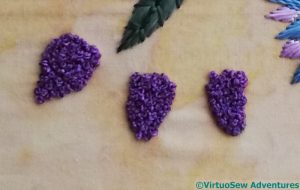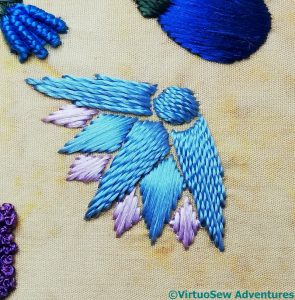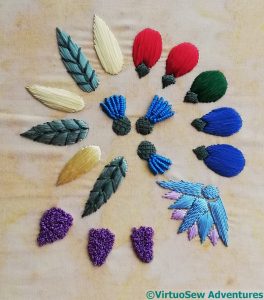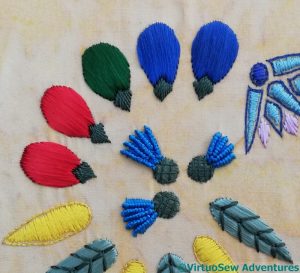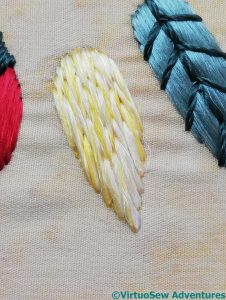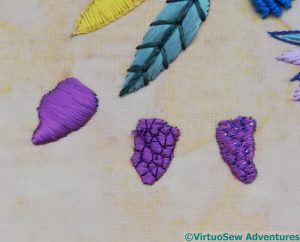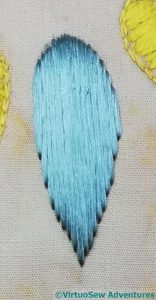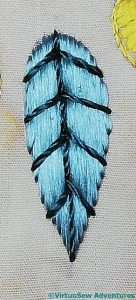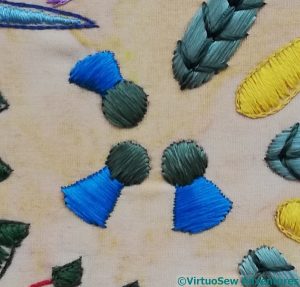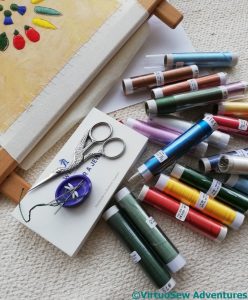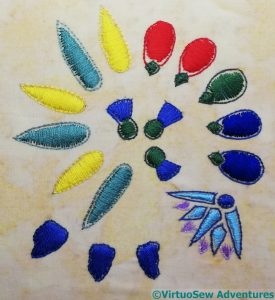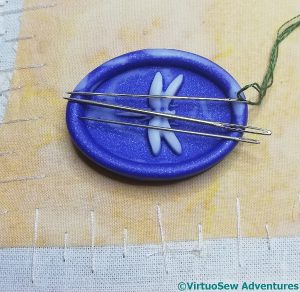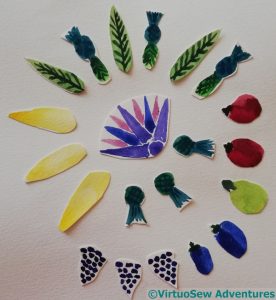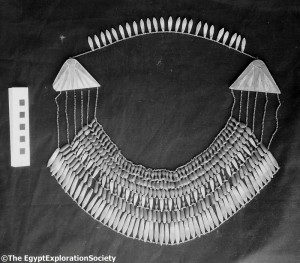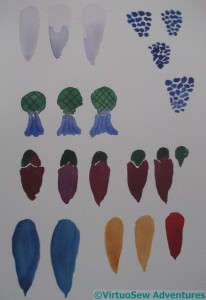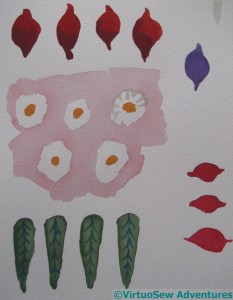Tag: Faience Necklace
Finishing the Faience Necklace
In the end, I unpicked both of the previous attempts, and used a mass of French knots, worked again in hand twisted silk, this time combining some of the very fine silk from a Frostings box with my Japanese Flat silk.
I think these work well, especially at the small scale of the piece.
I’d been rather dreading the large lotus flower, representing the shaped endpieces of a broad collar necklace, because I was remembering the struggle I’d had with the “Fragment of Tile That Started It All“.
Then I had an epiphany of my own, and used the difference in appearance and reflectance of twisted silk compared with flat silk to help distinguish the shapes of the petals and bring the foremost ones forwards. I’m very pleased with how that turned out!
And now, finally, it’s done!
This one is almost certainly going to be one of the “spots” around one of the big panels, because although I like it, and it represents what I want it to, I don’t think it has the visual strength to stand alone.
But then, if all the pieces could stand on their own, I wouldn’t be able to assemble the panels I want to, would I!
Finally, Episode 14 of SlowTV Stitchery is now live, discussing design thoughts, music and musicians. Do drop in and see how I’m getting on!
Steps forward, steps back
The necklace description that Mary Chubb was asked to transcribe, after her epiphany in the cellar, includes a row of dates in a repeating colour pattern of two red, one green, two blue.
So here they are, in satin stitch in flat silk for the main fruit, and more satin stitch, but this time using hand-twisted threads, for the stem. I found a rich and vibrant green for the main green fruit and used a greyish-green for the stem. Again, I’m trying to balance echoing the faience with echoing the real fruits, leaves and flowers, which is making for some interesting puzzles!
I wanted to try blending the silk filaments for one of the elements, to help recall the slightly iridescent effect of some glazes, and spent a wonderfully painstaking (exasperating!) afternoon splitting my silk. And then recombining it, and using it to stitch the first of the lotus petals in long-and-short stitch.
Only to sit back and glare at it. It’s looking congested, chunky, and not at all what I was looking for. What’s more, it’s buckling the fabric in spite of the calico support.
Snip, snip, out it comes, and now I need to think again.
Meanwhile I have another element to think about as well. You can see the underlayer of satin stitch on the shapes which are supposed to be recollections of bunches of grapes, and then two attempts to give them a more defined appearance. I think I prefer the middle version, which was the second I did.
That, however, means I have to unpick my first attempt. Sigh.
There was a problem with uploading my video last week, so here it is, somewhat delayed: Episode 10 of SlowTVStitchery. And, just so we don’t get too far behind ourselves: Episode 11 as well!
More progress on the Faience Necklace
There is another episode of SlowTV Stitchery up – Episode Three. I’ve also done two shorts, one introducing the Dreams of Amarna project as a whole, and one, for the Amarna Family Group in particular. Please ask me any questions you like, either here in the comments, or by email, and I will try to answer them in one of the later episodes. It might take a while, though, because people have been stacking up questions like cordwood!
Now, back to the Faience Necklace, which I’ve neglected… The first elements I decided to do were among the simplest – the three palm leaves.
First layer, as I said, is plain satin stitch in flat silk. Satin stitch makes me nervous, but flat silk spreads and blends together, which makes it about as easy as it can be for me.
The next stage was to hand-twist a two ply perlé -type thread to stitch the veins, using straight stitches. In this case, I used two of the strands of filaments for each ply, and I tried not to over-twist the final assembly.
That made for a lovely thread, with a bit of body and “lift”. A pleasure to use!
If I have correctly interpreted the description that Mary Chubb typed out on that first afternoon, when she came back from her epiphany in the cellar, this shape was described as a cornflower, so I went with my brightest blue, and the middle greyish-green shade for the calyx.
You will notice that the stitching on the two sections is at right angles one to the other. I realise that the stitching on the “petals” is not going in the obvious correct direction, but wait – there’s more…!
Quite a lot more, in fact.
First, trellis couching on the calyx, using a fine 2-ply thread twisted using a half-strand of flat silk for each ply, and twisted as tightly as I could manage without snarls or tangles.
Then, using the bright blue, I twisted another 2-ply thread, this time using three strands for each ply, and again, trying not to over-twist. Then I could use it to work some long bullion knots, creating the slightly fluffy effect of an opening flower.
I think this is going well so far!
Progress on the Faience Necklace
I love flat silk. The colours fairly glow, and it gives you endless options for creating threads of different thicknesses and twist levels. I’m hoping to use at least some of those possibilities in this project, to represent the gloss effect of the brightly coloured faience broad collars that inspired it.
I’m sure I’m missing some of the possibilities, but the mere fact that I’m excited and intrigued by what I’ve already thought of tells me that my holiday with the Three Wise Hounds was the right thing to have been doing.
The first thing I have to do is to pad all the elements. I’ve padded them using stranded cotton, which has a bit more body than the silk. I don’t have quite the right colours, but trust me, that’s not going to matter, as the padding won’t be seen.
There are at least two layers of padding almost everywhere (only one for the lilac tips of the backmost petals of the open lotus flower), and most of them have four. The padding stitches of each layer are at an angle relative to the previous layer, which stops them sinking into one another.
The basis of each element is going to be satin stitch in flat silk. The flat silk spreads beautifully over the cotton padding, so that at least will be pleasing to see.
I’ve set my frame up properly this time, with the fabric you will see supported by calico, and the combination is strong and taut enough to bear the weight of my little magnetic needle keeper. It’s the first time I’ve been able to use one, and it’s turning out very useful indeed. I’ve had it for a couple of years, and now I am wondering what took me so long.
Finally starting the Faience Necklace
When, after my holiday with the Hounds, I came back to the Faience Necklace designs I’d created with my painted cutouts, I found that the version I’d liked then no longer appealed. Instead, it was the various spirals that sprang out at me, so I began to play with them a little more, tweaking and varying the design.
I must remember paper cutouts as a future designing method. It makes it much easier to play with a lot of variants in a relatively short space of time!
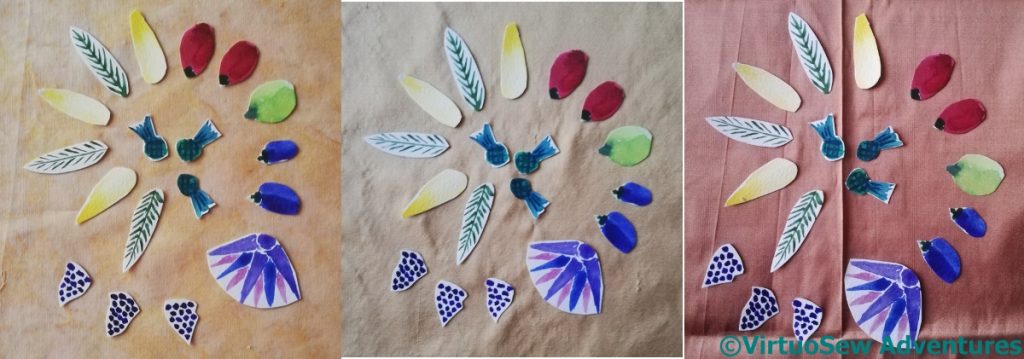
Then I had to decide on a fabric. No, I hadn’t ironed the silk on the right. This was very much an improvisation! From left to right – a quilting cotton I used in “Loading The Felucca“, a leftover of the silk I used for the “Head of Ankhsenpaaten“, and a silk in a shade very similar to that used for the “Colossus of Akhenaten“. In the end I decided that the sandy print on the cotton would help to evoke that sand in which they were digging, and framed up. I’ve put a calico backing in in the frame, and attached the cotton over the top.
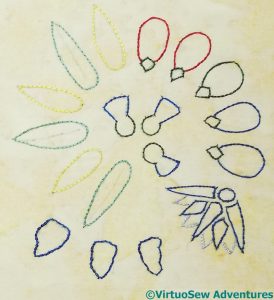
Since it’s winter, I’ve been working under my craft light, and it does rather wash out colours. I’m using Japanese flat silk (not sure why, it just seemed to be what I wanted to do), and I’ve started by hand-twisting some fine thread and outlining each element in reverse chain stitch.
This does two things – it covers the design transfer lines and it allows me to think about how I’m going to tackle it. Originally I was going to work each element in satin stitch, to echo the high gloss of the faience, but now I’m beginning to think more and more of using stitch to echo the natural elements the faience depicts. Remember what I said, when I finished the Hounds, about returning to my first love, the effects of stitch and thread?
The Faience Necklace – still thinking…
After her discovery of the piece of tile that started it all, the first find that Mary Chubb describes is a faience necklace, discovered by the team then in Egypt, and written up in the Director’s Report which she has to disentangle and re-type legibly (remember, in the 1920s, typing wasn’t a skill that everyone had had to develop). It sounds completely enchanting, and yet I’m struggling to bring it to life.
In fact I last wrote about it in 2015, and I’m still wrestling with ways to represent it! I’ve already abandoned any idea of working a portrait of it (as it were). As you can see from the black and white photo, it’s crammed with faience beads, and it’s hard to imagine making a good stitchable design of it. So I’ve cut out some watercoloured beads, and pushed them around, taking photos as I go. Back to primary school!
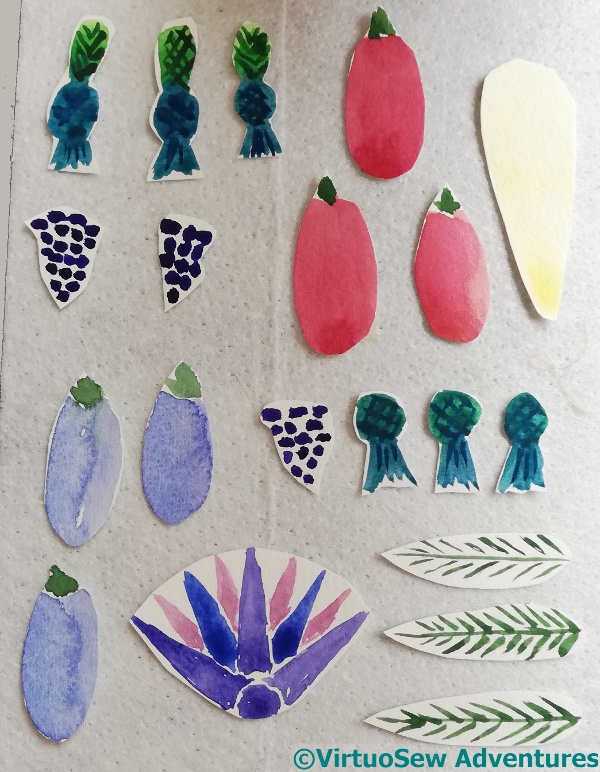
1 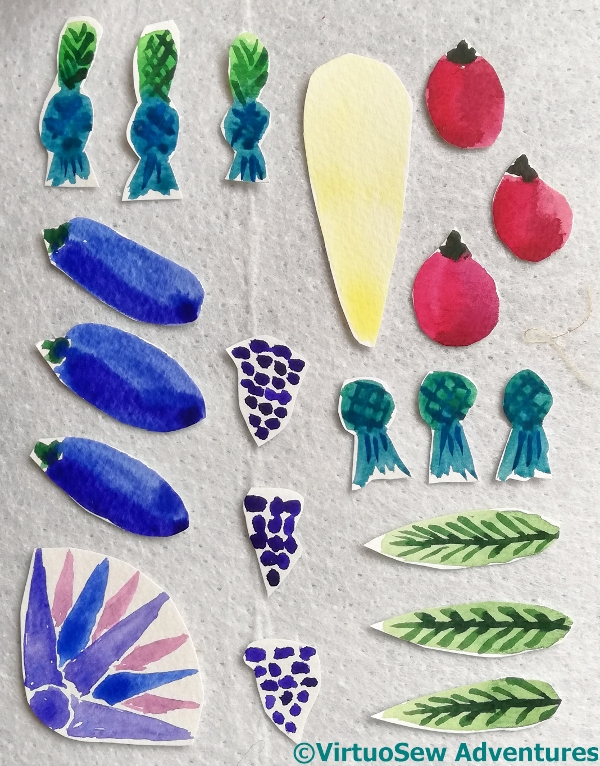
2 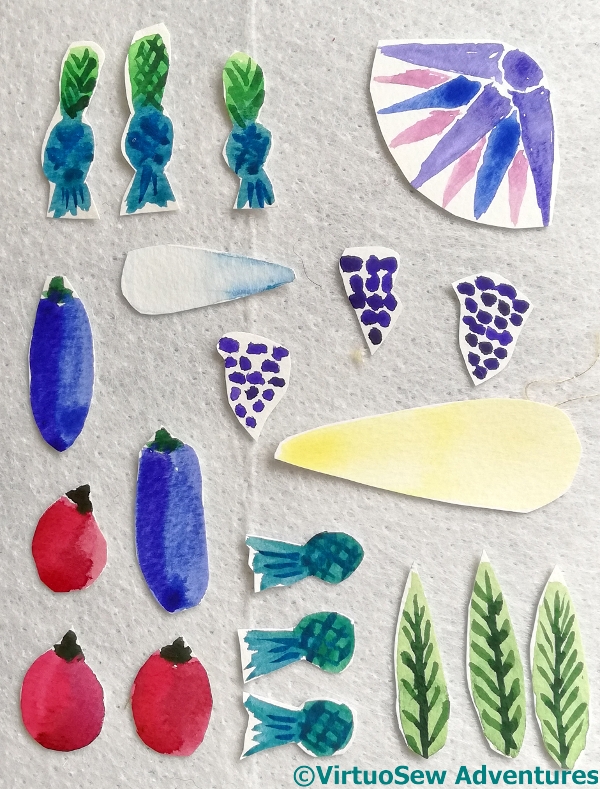
3 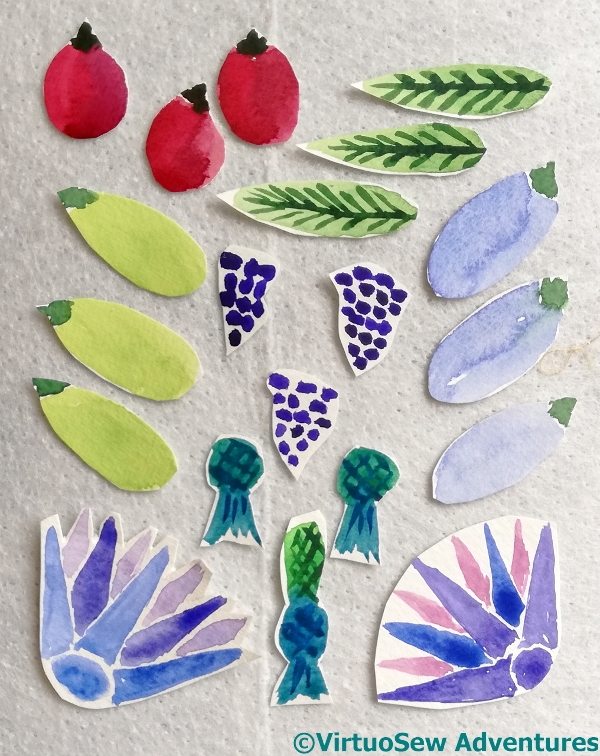
4 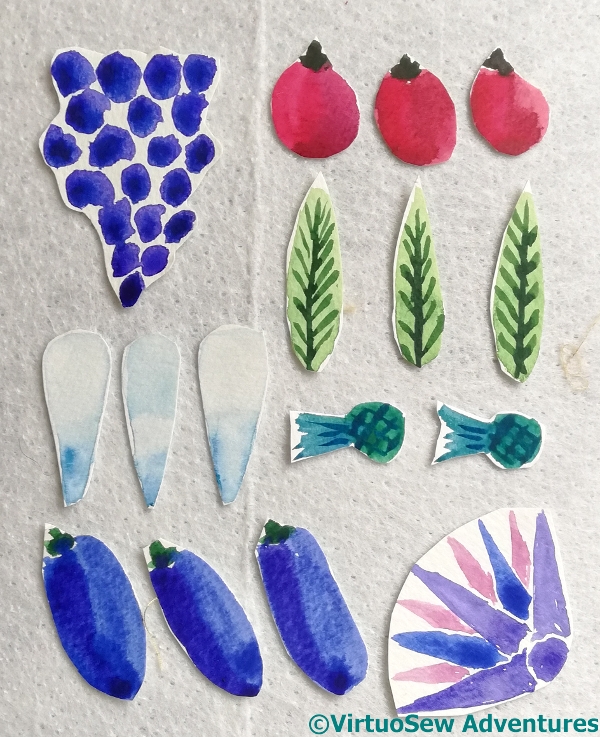
5 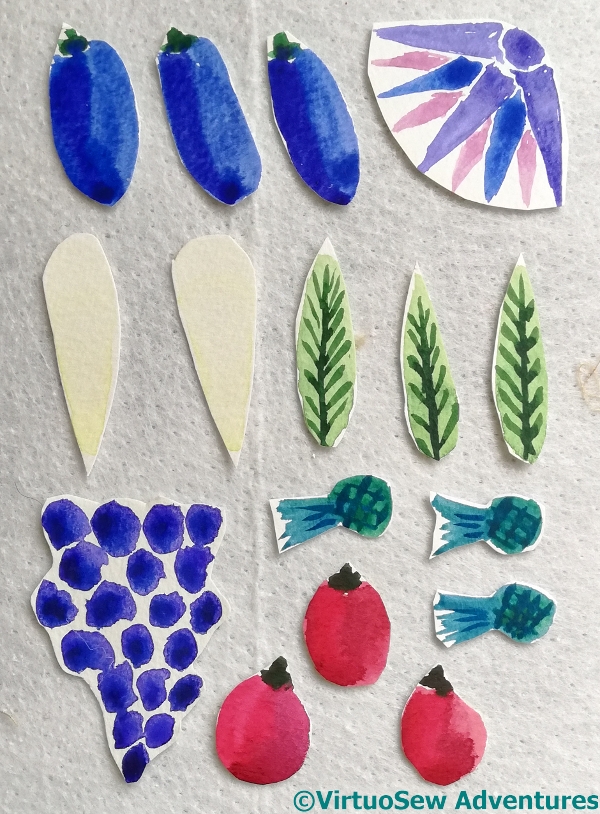
6
Then another suggestion came in (thank you @IndiaGraceDsgns ), to think about mandalas…
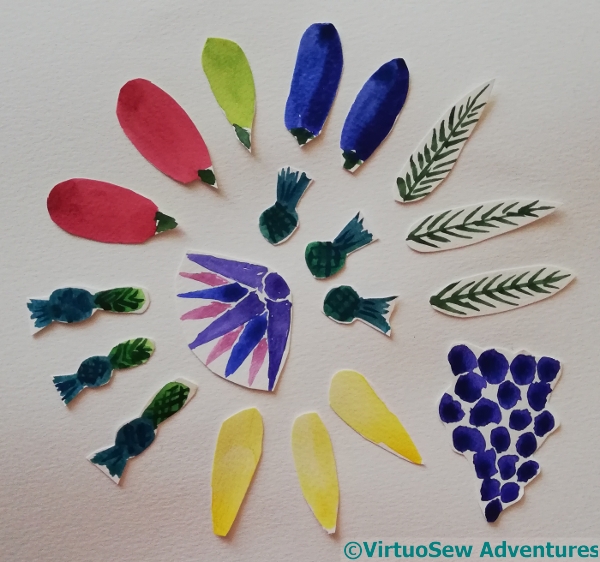
7 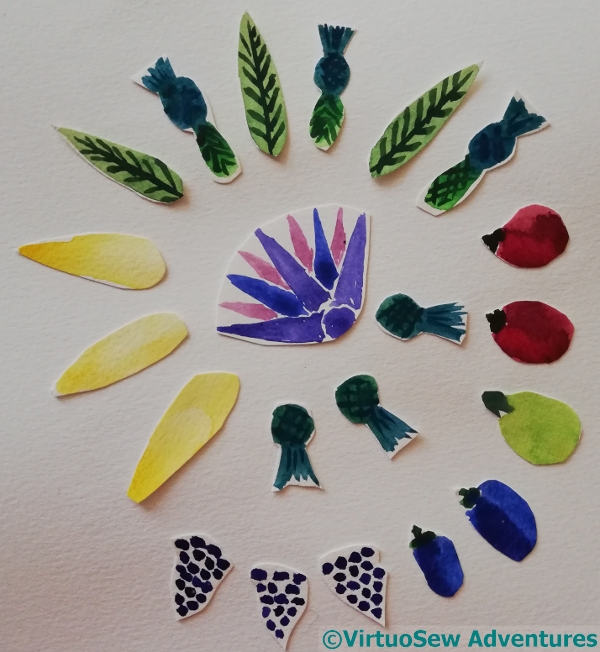
8 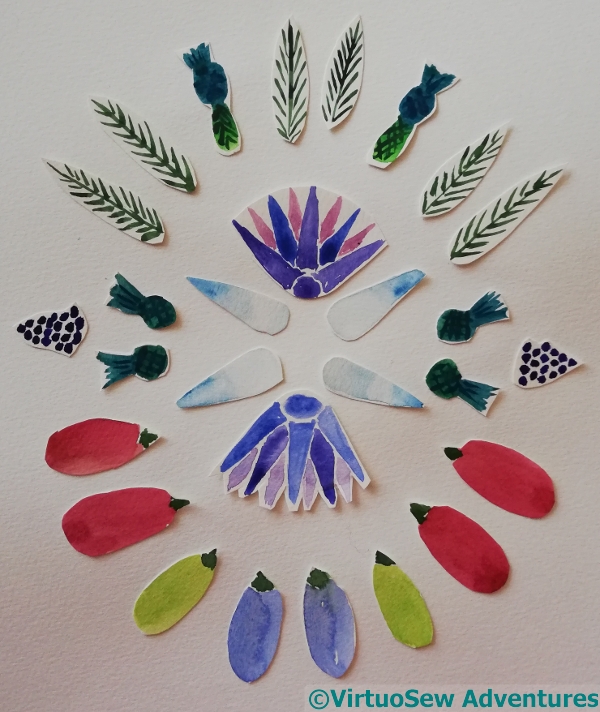
9
And now I’m thinking about “samplers” of beads which still recall the way these broad collars and necklaces are sometimes displayed in museums.
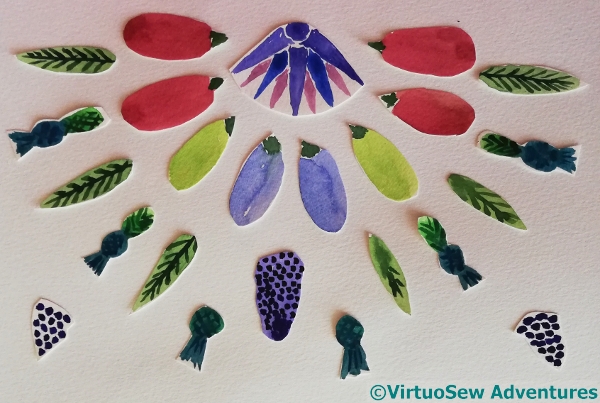
10 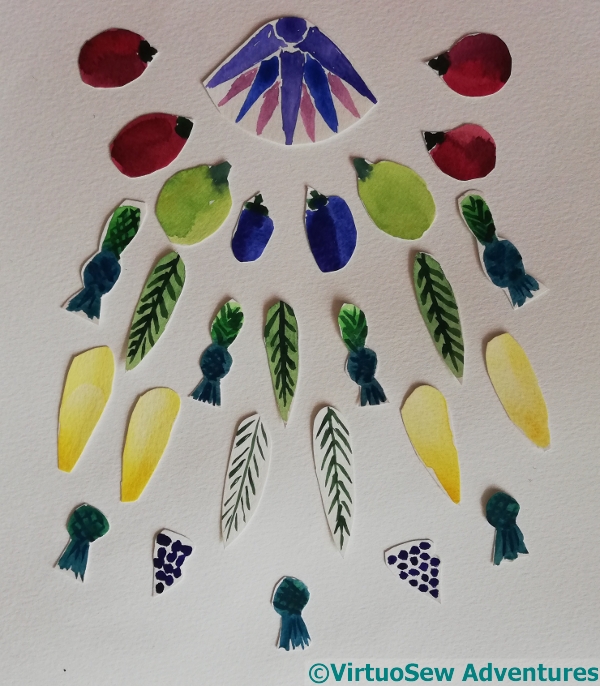
11 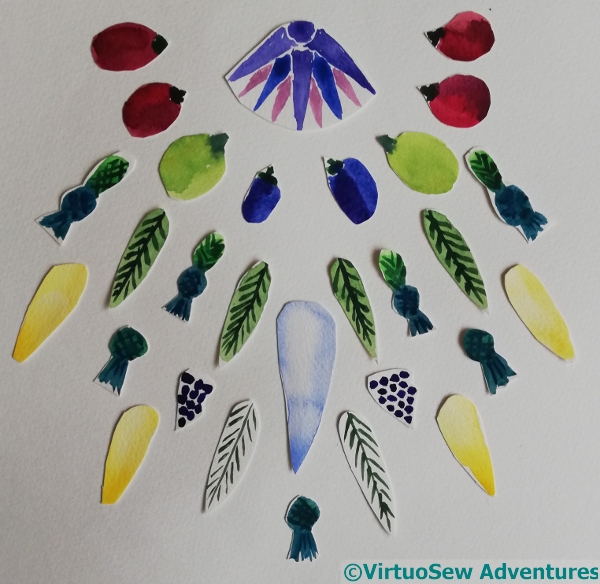
12 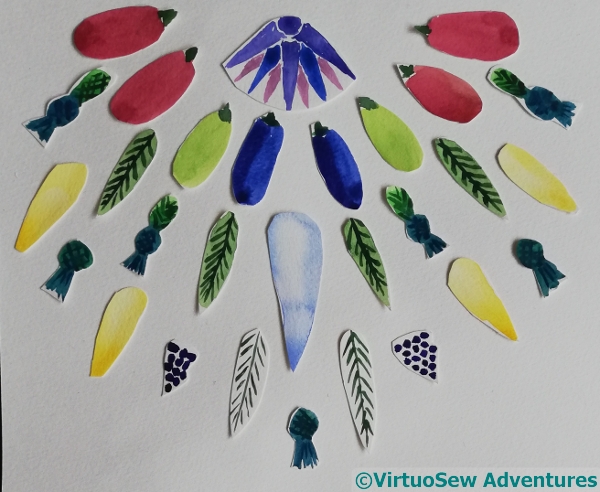
13
I’m planning on using flat silks, when I finally pick one (comments, anyone?), and of course, the next question will be: what colour fabric I will be stitching it on?
The Faience Necklace
After Mary Chubb had her moment of epiphany with the tile fragment I reinvented for The Fragment of Tile That Started It All in that Bloomsbury basement, she returned to the office, and her first task was to re-type a recently-arrived Director’s report, since it arrived in no state for publication (“Typed on camelback in a sandstorm“, as she described it).
The first item described in that (shockingly mis-typed) report is a necklace of faience, made using rows and rows of faience shapes in different colours, shaped to depict fruits, leaves, and flowers.
Naturally, I want to embroider a piece that will recall that necklace. Equally, as you can see in the photograph, if I were to attempt to embroider the whole thing, it would either have to be huge, or it will risk being tiny, cramped, and not doing justice to the enchantment she describes.
So I have decided that I am going to create a design that shows only a segment of the necklace. So far that has been hard to do.
I have tried several draftings and redraftings, and these watercolour fragments are the beginnings of the fourth (or is it the fifth?) attempt to devise something reasonable. I am trying to learn the shapes of the various elements – lotus petals, bunches of grapes, cornflowers, dates, palm leaves.
What happens next is for another time. I may well be back once more to primary school, cutting out and sticking down pieces of paper.
I’m so keen to use all my shiniest threads to depict the faience that I’m becoming very short-tempered with myself…!

